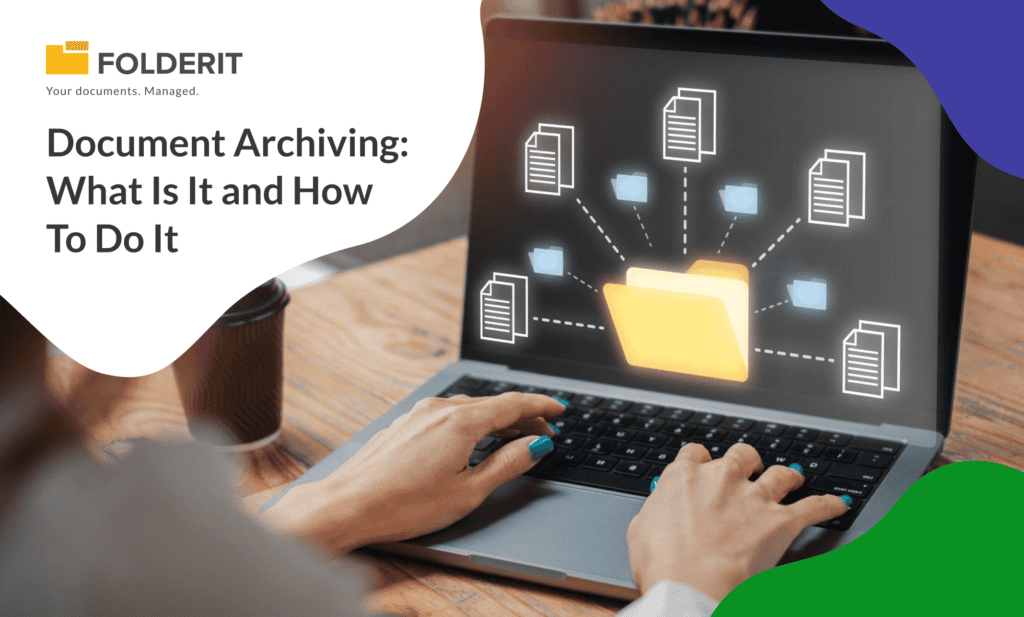Companies are swimming in documents, regardless of what industry they may be in. These documents can broadly be given two statuses, in-use and inactive. Many of these documents are important for companies, due to which they must be kept for a set time period or indefinitely, especially if they are inactive. These business documents or records need to be managed, circulated, and archived based on company policies and legal compliance directives, this process, or more specifically document archiving, is an essential part of any company’s information and document management strategy.
What is Document Archiving
Document archiving is a strategic necessity for companies of all sizes, this process involves placing inactive documents or “records” into long-term storage, while also ensuring easy retrieval of said documents whenever they are needed.
For additional clarity, it must be understood that a document is considered to be a record once a document process is complete, or more simply put, that the specific document and associated process are considered “complete”. A more formal definition would be that Documents are “declared” to be records when they provide evidence of actions or decisions at a particular time and place.
Types of Document Archiving
Before delving into the two main types of document archiving, its important to point out that in most cases there are no explicit laws or regulations that mandate saving documents on paper or digital storage. In most cases, both meet the same legal and compliance requirements.
Though it is recommended as a safety measure to also keep certain documents in a paper format as well, these include wills, trusts, notarized contracts with raised seals, titles to properties, promissory notes, and documents of a similar nature. We recommend keeping both physical and digital copies of these documents.
Physical Archiving
This is the traditional method of storing paper-based documents in secure physical locations, these can be on-site as in the case of filing rooms, filing cabinets, and archive rooms, or can be in off-site archival locations.
Although this type of archiving is still quite prevalent in some industries, it is significantly labor-intensive, prone to loss or damage, and just overall inefficient, in comparison to electronic archiving and storage.
Digital Archiving
As with the previous, this one is pretty self-explanatory. Digital archiving involves scanning and digitalizing paper documents for long-term storage on things like local servers, cloud storage, hard drives, etc. It’s an increasingly prevalent method of document storage and management now owing to its many benefits. Digital archiving saves you space, makes document retrieval easier, and has better security options. Cloud-based document management systems like Folderit provide an even greater degree of accessibility and provide significant disaster recovery.
How to Implement a Document Archiving Strategy
If you want to implement an efficient document archiving strategy you need to have a clear and systematic approach when it comes to these things, making sure documents are stored securely, also remain accessible, and most importantly comply with legal and operational requirements.
A well-thought-out strategy kills two birds with one stone, that is it streamlines the retrieval process, alongside safeguarding critical information for long-term use.
Step 1: Conduct an Initial Document Audit
Before beginning the archiving process, it’s important to initiate a comprehensive internal audit of all existing documents. This audit helps to identify and which documents should be archived, which should be discarded or lastly which should remain active.
Some important considerations for this step include:
- Document Types:
Identifying which types of documents require long-term storage (e.g., financial records, contracts, compliance documents) - Access Frequency:
Separating frequently accessed documents from those that are rarely used - Legal and Regulatory Requirements:
Maintain compliance by identifying documents that must be archived to meet specific legal or regulatory mandates (e.g., GDPR, HIPAA, SOX)
Step 2: Establish a Document Retention Schedule
Now, this step is pretty important for legal compliance, as well as automation, that is setting up a document retention schedule. A well-defined retention schedule is mandatory for an organization that is planning on effectively managing documentation and archiving.
Why? Because it makes sure that documents are archived for the appropriate amount of time. Retention periods vary based on document type and industry regulations.
Any good retention policy should include:
- Retention Periods:
Specify to how long each type of document should be archived. For example, tax records might need to be retained for seven years, while contracts may require indefinite storage - Document Destruction Policy:
Establish criteria for safely deleting records that are no longer needed after the retention period has passed. This maintains compliance with data protection laws while minimizing storage costs
Step 3: Choose the Right Archiving Method
The next step is to select the right archiving method based on your organization’s needs.
Options for these include:
- On-Premises Digital Storage:
Hosting a secure digital archive on-premises for organizations with sensitive data can offer better control and data protection - Cloud-Based Solutions:
Cloud-based archiving offers scalability and cost-efficiency. It’s ideal for organizations looking to minimize hardware investments and optimize access from multiple locations - Hybrid Approach:
Some organizations may benefit from a combination of physical and digital archiving, especially when transitioning from paper-based systems to a fully digital archive
Step 4: Digitize and Index Physical Documents
For companies transitioning from physical to digital archives, document digitization is a critical step. Scanning paper documents into digital formats like PDF/A allows for long-term storage and easier access.
Important steps for transitioning include:
- Scanning and OCR:
Use Advanced Optical Character Recognition (OCR) to convert paper documents into searchable digital files - Metadata Creation:
Assign metadata such as document type, creation date, author, and retention period to improve searchability and classification. A good document management system like Folderit allows for extensive metadata creation and tagging
Step 5: Implement Security and Compliance Measures
Data security and access control are paramount in document archiving. Archived documents often contain sensitive information and poor access management can also lead to compliance violations, so it’s important to implement stringent security protocols:
- Access Control:
Set up role-based access control to ensure only authorized personnel can access, modify, or retrieve documents - Encryption:
Use strong encryption methods like 256-bit SSL encryption to protect archived files from unauthorized access - Audit Trails:
Maintain detailed audit trails to monitor who accessed or modified specific documents. This is especially important for compliance audits
Step 6: Automate the Archiving Process
Automation is your best friend in almost all scenarios, and it is no different in the document archiving process. Automation can significantly improve the efficiency and accuracy of the archiving process.
Advanced automated document management systems allow for:
- Scheduled Archiving:
Automate archiving based on predefined rules, such as file age or document type, ensuring that documents are archived as soon as they meet the criteria - Error Reduction:
Automated systems help reduce human errors, ensuring that documents are properly indexed and stored - Real-Time Access:
Automation ensures instant retrieval of archived documents from anywhere and any device, improving operational efficiency
Step 7: Regularly Audit and Update Your Archive
Any effective archiving strategy requires ongoing maintenance and regular audits. Periodic reviews ensure that the archive remains compliant and functional:
Some key things that should be kept in mind:
- Audit Archival Policies:
Regularly review your archiving policies to make sure they align with the latest regulatory requirements - Update Technology:
Ensure that your archiving system evolves with technology, especially to prevent data loss from obsolete file formats or outdated storage solutions
What Types of Documents Should You Digitize and Archive?
The documents you archive depend on your business’s needs and any legal or industry requirements. Each serves a purpose, whether it’s for compliance, internal operations, or long-term reference.
These documents usually include:
Legal Documents:
- Contracts and Agreements
- Compliance Records
- Legal Correspondence
Financial Documents:
- Invoices and Receipts
- Financial Statements
- Tax Records and Audit Reports
Human Resources (HR) Documents:
- Payroll Records
- Performance Reviews
- HR Policies and Procedures
Correspondence:
- Emails, Letters, Memos
Reports:
- Research, Proposals, Feasibility Studies
Corporate Policies:
- Policies, Procedures, and Manuals
Customer Records:
- Client Orders, Contracts, and Feedback
Intellectual Property:
- Patents, Trademarks, Copyrights
- Licensing Agreements
Educational Records:
- Transcripts, Student Records
- Educational Policies
Project Documents:
- Project Plans and Reports
- Meeting Minutes
Technical Specifications:
- Manuals, Engineering Documents, Drawings
Environmental and Safety Documents:
- Safety Procedures and Incident Reports
- Certifications
Conclusion
A solid document archiving strategy is important to staying compliant, improving and maintaining efficiency, and keeping your data safe long-term. By using best practices like regular audits, setting clear retention schedules, and taking advantage of automation, you can create a system that works for both current and future needs.



